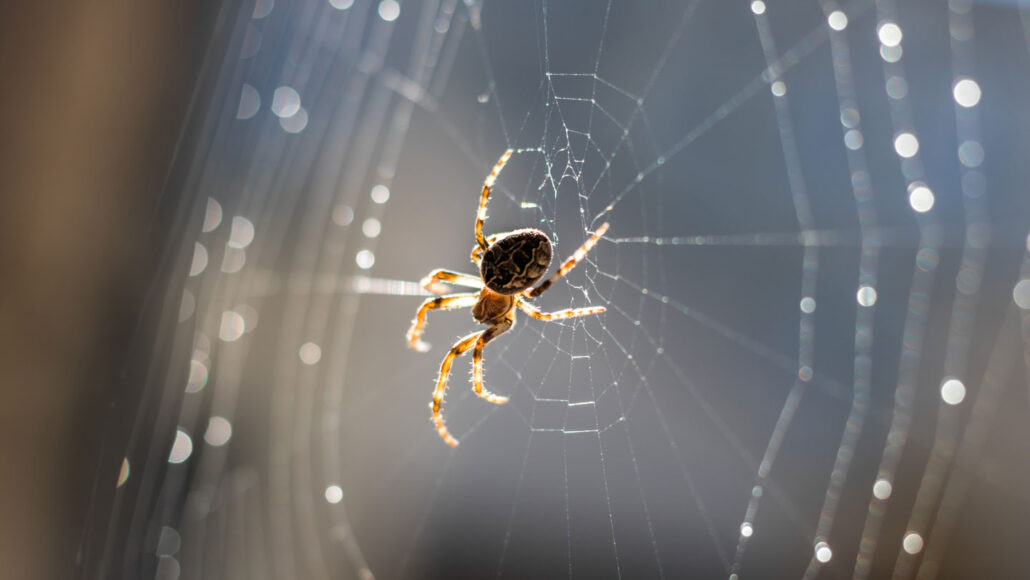Orb-weaving spiders use their webs like external eardrums
They listen with their legs, detecting sound vibrations that travel through the silk

Orb-weaving spiders detect sound vibrations that travel through the silk of their webs.
Mateusz Kropiwnicki/iStock / Getty Images Plus
In the story Charlotte’s Web, a spider wrote messages in her web. It now appears some spiders also listen with that silk. One might now think of those webs as ears — replaceable ears.
Most animals have something like an eardrum that responds to sound. Spiders don’t. They sense vibrations through their legs. This helps them know when their silky webs have snagged an insect meal. A new study finds spiders also use their webs to listen to sound. What’s more, they can adjust the web to change how they hear.
A bridge spiders’ wispy, wheel-shaped web acts as a super-sensitive antenna to capture the sound-movements of air particles, the new study finds. And it acts like a big ear, at that. Some of these webs may have a sensing surface up to 10,000 times the size of the spider. This webby “ear” works so well, the study’s authors now report, that its efficiency is “better than the acoustic responsivity of all previously known eardrums.”
The new findings appeared March 29 in the Proceedings of the National Academy of Sciences.
“It’s a super-cool study,” says Eileen Hebets. An arachnologist, she works at the University of Nebraska–Lincoln and was not involved with the research. She says the study shows “us yet again how amazingly sophisticated spiders are.”
Ron Miles has been studying spiders and insects for 30 years. He’s a mechanical engineer at Binghamton University in New York. In his work to develop better microphones, Miles studies animals that lack eardrums. “Typical microphones measure only air pressure,” he says. So do our eardrums. But sound involves both pressure and the movement of individual air particles. His team wanted to measure this air movement that accompanies pressure changes.
For their new study, he and his team worked with bridge spiders. These animals build large, round (orb) webs, then hang out in the center as they await their web to snag them a meal.
Sound travels through the air in waves. In a previous study, Miles was part of a team found that a single strand of spider silk vibrates with moving air. This made the researchers wonder whether the silk might act like an extended eardrum. Being able to listen for approaching prey or — perhaps more importantly — predators, could help spiders survive.
New kind of hearing test
To test this, they collected 60 bridge spiders. In the lab, they housed each in its own container and gave it a 30-centimeter (12-inch) square frame in which to build a web. The researchers then took individual spiders on their webs into a special room. Its walls were covered in thick, triangular pieces of foam. These absorb sound and prevented any echoes from interfering with their study.
The team directed a speaker at a spider’s web. Sometimes that speaker was directly in front of the web at a distance of three meters (10 feet). Other times, it was to the right or left of the web at a 45-degree angle. Videos recorded the spider at rest and while exposed to a five-second tone. Some tones mimicked the sounds made by common prey, such as crickets. Others might be associated with an approaching predator. During a single trial, a spider experienced just one tone. Over the course of the experiment, it heard tones at different frequencies and volumes.
The spiders responded to the tones by crouching, flattening their bodies, lifting their front legs or turning to the side. When sounds came from the side, the spiders turned in the direction of the speaker. When they crouched or stretched, they moved strands of silk, which may have changed how they detected vibrations.
It’s possible the spiders do have eardrums that just haven’t been discovered yet. To test this, the team put a tiny speaker just two millimeters — about the thickness of a coin — away from the web. The speaker was five centimeters (two inches) away from the spider. Sound doesn’t travel well through air. By the time it reached the spider, it would have been very quiet. But sound travels well through the spider silk.
When the researchers played a tone, the spiders responded, even though any internal eardrums would not have been able to pick up the sound. This demonstrates that the spiders weren’t listening to sound the way we do. Rather, they were picking up vibrations from their webs.
Drawing inspiration from nature
“Normally we think of spiders as being unable to hear like we do,” says Trinity Walls. She’s a behavioral ecologist at the University of California, Berkeley, who did not take part in the study. It appears spiders build their own “ears” with silk and modify them with their body movements. “Hopefully, we as humans can learn from their techniques and maybe even use them to improve or rectify human hearing loss,” she says.
In fact, Miles and his team hope to use their new findings to reimagine how microphones work. “All microphones are designed to sense pressure only,” he says. They “completely ignore the possibility of sensing the motion of the air.” He hopes to create microphones that also can sense the tiny flow of air in a sound field. This airflow could “indicate the direction to a sound source,” Miles explains. Knowing where any unwanted sounds are coming from “helps us figure out how to get rid of [noise].”
“Much more work should be done to figure out what the sounds mean to the spider,” Miles adds, “now that we know spiders can use their web to hear.”
Miles encourages curious teens to pay attention to what’s around them. “Sometimes things we see every day,” he says — such as spider webs — “can contain fascinating mysteries which you can unravel by careful investigation.”







